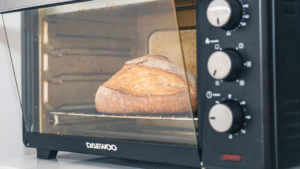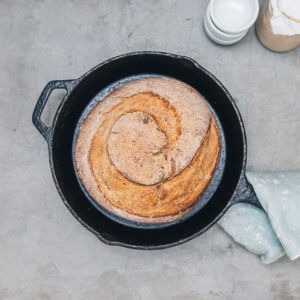
Rosemary Sourdough Bread
Elevate your regular sourdough with the aromatic and flavorful dried herb rosemary. Recipe produces a 968 gram, 20cm in diameter, 10cm in height, 65% hydration-level loaf of sourdough bread.
Equipment
- Mixing Bowl - Glass or Plastic
- Saran Wrap or Towel
- Baking Pan - Stone or Tin Pizza Pan, Cast Iron or Dutch Oven
- Kitchen Scale
Ingredients
- 75g Sourdough Starter
- 600g Flour Recommended: 80% White (480g), 20% Whole Wheat (120g)
- 1 tsp Dried Rosemary
- 390g Water This is a 65% hydration level of water to your dry flour weight (it excludes the difference counted by a starter).
- 12g Salt This is 2% of your total dry flour weight. 12g of salt is close to 3/4 tablespoons.
Instructions
- In a bowl, mix 600 grams of flour and (approximately) 1 teaspoon of dried rosemary. Do not add salt yet!
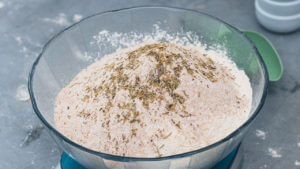
- Add 390 grams of water to your mixing bowl.
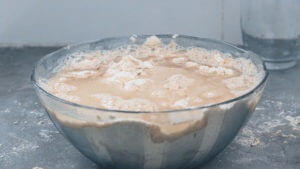
- Gently mix water and slowly form a ball of dough.
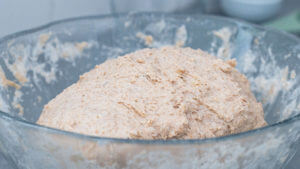
- Let dough autolyse for the recommended time of 1 hour. This allows gluten to form and bind together, strengthening the dough before fermentation starts. Optionally, you can let autolyse for as little as 15m, or as long as 8 hours. Adjust to your schedule. From practice, 45 minutes to 1 hour seems to achieve the best results. Cover bowl in saran wrap or damp towel during this process, and after the following steps too.
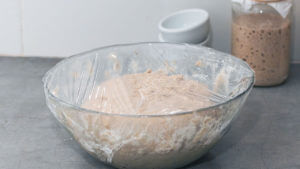
- Gently mix in 75g of active starter. Ideally use once your starter has peaked or doubled in size since its last feeding. Do not stretch or mix your dough so aggressively that it begins to break or tear.
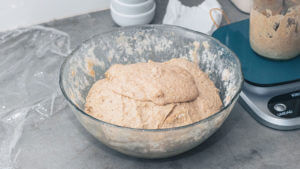
- After 15 to 30 minutes of allowing your the dough to begin fermentation, mix in 12 grams of salt.Some bakers prefer to dissolve their salt into warm water, then spread into their dough. It's entirely up to you.
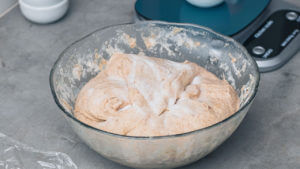
- While your dough is still in the mixing bowl, begin series of stretch and folds. It's a good idea to space them out every 30 minutes. Three sets of stretch and folds is usually adequate. You can accomplish this by pinching a part, then persuasively stretch that piece (without tearing the dough), and folding over and onto itself. Do this in about 3-4 places. This will help develop more strength in the dough. Toward the end of your stretch and folds the dough should be noticeably less prone to tearing.
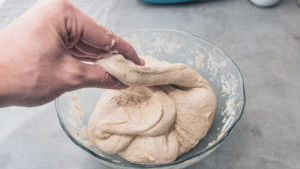
- Time to bulk ferment your dough! Let dough to sit while covered at room temperature for anywhere between 3-7 hours. The warmer your house is, the less time it will need. It's finished this process if; the dough has doubled in size, appears to be dome-shaped on the top, and has a smooth surface. There are lots of resources that exist if you're having trouble learning how to gauge this part. If it's winter where you live, and your house is quite cold, this process can easily take 12 hours. Many people in cold circumstances opt to prepare their bread at night, leave it on the counter overnight, and then bake in the morning.
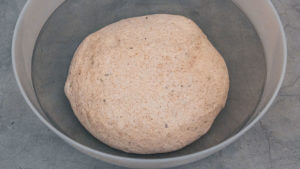
- Once the dough has finished its bulk ferment, you have the option of further developing the taste through cold fermentation in the fridge. This can be 12 to 24 hours. The longer, the more developed the taste will be. It is possible to cold ferment for longer than this time-frame, however, you must be very familiar with the whole process and time things exceptionally well as to not over-proof.
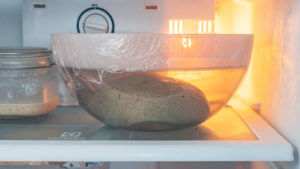
- Either after your bulk or cold ferment, it's time to shape your dough. Some choose to shape then place in a proofing basket before putting in the fridge for a cold ferment. Some choose to shape a little before baking. Proofing bannetons are nice, just not necessary. There are various shaping techniques that exist. The basic idea is to form a round dough with built up pressure. If there's no pressure built prior to baking, the bread may result in being flat. Too much pressure might make the bread too dense or not rise properly. If the dough didn't have a chance to build its gluten strength or if it over-proofed, it won't want to keep its shape. Even if you choose to shape immediately before baking, it's a good idea to let it rest for 5 to 15 minutes before putting in the oven as to avoid it being too dense. If it's having issues keeping any shape, don't let it rest. Simply shape, then throw in the oven and pray it won't become a pancake loaf.
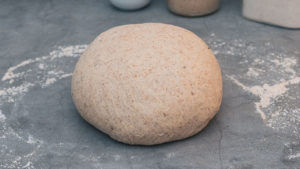
- First and optional: oil the surface of your dough, then lightly sprinkle flour over it. Second, and not optional: With a bread scoring knife, create at least one score just off center, or score in whichever pattern you like.A bread score allows steam to escape the dough while baking. Otherwise, you may risk the dough cracking or bursting in an undesired way while in the oven. Utility blades, sharp pocket knives, or kitchen knives can do a sufficient job, they'll be less pretty than a bread scorer. A bread scoring blade is slightly bent, giving you a curled "ear" on your bread crust.
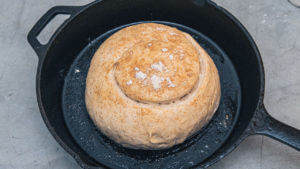
- Bake at 475° Fahrenheit (246° C) for about 1 hour. If your bread is dark golden on the top surface, or if it has reached an internal temperature of 94°-98° C (201°-208 F), then it is done. It may hit those temperatures in 30 minutes, or in 1.5 hours. Check regularly if it's your first time.475° for this length of time is a general guideline. You'll get the best results by paying attention to what your bread likes best from your oven. What bread is baked in or on and whether the oven was pre-heated sufficiently changes the bake time. The kind of flour used can also change what is needed. And the size of your loaf will affect the baking. You can bake on a stone or tin pizza pan, cast iron pan, or dutch oven. If baking with a dutch oven, line the inside with non-stick parchment and keep the lid on during the first part. You can remove the lid for the last 10-20 minutes to get a nice color on the top crust. If you don't have a steam-injection oven, nor a dutch oven, you can get successful results baking on a pan by doing the following: ensure tin foil is underneath the pan (shiny side down) to repel the direct heat from burning the bottom crust, and tenting the top of your bread with tin foil (shiny side outward) to repel direct heat from burning the top of your bread (even in a convection). You can remove the top tin foil 10-20 minutes before the end of the bake.
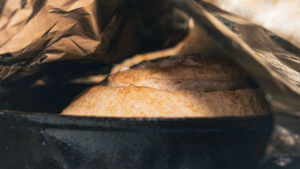
- Let bread rest for one hour. Allowing it to finalize itself on the inside. Otherwise it can be too gummy if you haven't waited.A great way to do this: rest it in the oven (while off) for the first 20 minutes keeping the door cracked. This helps the crust become a bit more crispy. Once done, allow it to sit on a baking rack for the final 40 minutes before cutting into it. Resting it on a flat sealed surface or storing in a bag before it has sufficiently cooled will drastically affect how crispy the outer crust is.
